Digital camera
A digital camera (also digicam or camera for short) is a camera that takes video or still photographs, or both, digitally by recording images via an electronic image sensor.
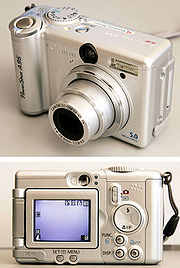
Many compact digital still cameras can record sound and moving video as well as still photographs. Most 21st century cameras are digital.[1]
Digital cameras can do things film cameras cannot: displaying images on a screen immediately after they are recorded, storing thousands of images on a single small memory device, recording video with sound, and deleting images to free storage space. Some can crop pictures and perform other elementary image editing. The optical system works the same as in film cameras, typically using a lens with a variable diaphragm to focus light onto an image pickup device. The diaphragm and shutter admit the correct amount of light to the imager, just as with film but the image pickup device is electronic rather than chemical.
Digital cameras are incorporated into many devices ranging from PDAs and mobile phones (called camera phones) to vehicles. The Hubble Space Telescope and other astronomical devices are essentially specialized digital cameras.
Contents |
Types of digital cameras
Digital cameras are made in a wide range of sizes, prices and capabilities. The majority are camera phones, operated as a mobile application through the cellphone menu. Professional photographers and many amateurs use larger, more expensive digital single-lens reflex cameras (DSLR) for their greater versatility. Between these extremes lie digital compact cameras and bridge digital cameras that "bridge" the gap between amateur and professional cameras. Specialized cameras including multispectral imaging equipment and astrographs continue to serve the scientific, military, medical and other special purposes for which digital photography was invented.
Compact digital cameras
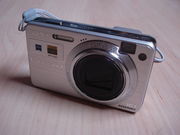
Compact cameras are designed to be small and portable and are particularly suitable for casual and "snapshot" use, thus are also called point-and-shoot camera. The smallest, generally less than 20 mm thick, are described as subcompacts or "ultra-compacts". Most, apart from ruggedized or water-resistant models, incorporate a retractable lens assembly allowing a thin camera to have a moderately long focal length and thus fully exploit an image sensor larger than that on a camera phone, and a mechanized lens cap to cover the lens when retracted.
Compact cameras are usually designed to be easy to use, sacrificing advanced features and picture quality for compactness and simplicity; images can usually only be stored using lossy compression (JPEG). Most have a built-in flash usually of low power, sufficient for nearby subjects. Live preview is almost always used to frame the photo. Most have limited motion picture capability. Compacts often have macro capability and zoom lenses but the zoom range is usually less than for bridge and DSLR cameras. Generally a contrast-detect autofocus system, using the image data from the live preview feed off the main imager, focuses the lens.
Typically, these cameras incorporate a nearly-silent leaf shutter into their lenses.
For lower cost and smaller size, these cameras typically use image sensors with a diagonal of approximately 6 mm, corresponding to a crop factor around 6. This gives them weaker low-light performance, greater depth of field, generally closer focusing ability, and smaller components than cameras using larger sensors.
Bridge cameras
Bridge are higher-end digital cameras that physically and ergonomically resemble DSLRs and share with them some advanced features, but share with compacts the use of a fixed lens and a small sensor. Like compacts, most use live preview to frame the image. Autofocus is achieved using the same contrast-detect mechanism, but many bridge cameras feature a manual focus mode, in some cases using a separate focus ring, for greater control.

Due to the combination of large physical size but a small sensor, many of these cameras have very highly specified lenses with large zoom range and fast aperture, partially compensating for the inability to change lenses. To compensate for the reduced sensitivity of their small sensors, these cameras almost always include an image stabilization system to enable longer handheld exposures.
These cameras are sometimes marketed as and confused with digital SLR cameras since the appearance is similar. Bridge cameras lack the reflex viewing system of DSLRs, have so far been fitted with fixed (non-interchangeable) lenses (although in some cases accessory wide-angle or telephoto converters can be attached to the lens), and can usually take movies with sound. The scene is composed by viewing either the liquid crystal display or the electronic viewfinder (EVF). Most have a longer shutter lag than a true dSLR, but they are capable of very good image quality (with sufficient light) while being more compact and lighter than DSLRs. High-end models of this type have comparable resolutions to low and mid-range DSLRs. Many of these cameras can store images in a Raw image format, or processed and JPEG compressed, or both (sometimes TIFF). The majority have a built-in flash similar to those found in DSLRs.
Mirrorless interchangeable lens camera
In late 2008 a new type of camera emerged, combining the larger sensors and interchangeable lenses of DSLRs with the live preview viewing system of compact cameras, either through an electronic viewfinder or on the rear LCD. These are simpler and more compact than DSLRs due to the removal of the mirror box, and typically emulate the handling and ergonomics of either DSLRs or compacts. As of 2009 the only such system is Micro Four Thirds, borrowing components from the Four Thirds DSLR system.
Digital single lens reflex cameras
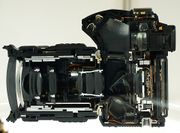
Digital single-lens reflex cameras (DSLRs) are digital cameras based on film single-lens reflex cameras (SLRs). They take their name from their unique viewing system, in which a mirror reflects light from the lens through a separate optical viewfinder. In order to capture an image the mirror is flipped out of the way, allowing light to fall on the imager. Since no light reaches the imager during framing, autofocus is accomplished using specialized sensors in the mirror box itself. Most 21st century DSLRs also have a "live view" mode that emulates the live preview system of compact cameras, when selected.
These cameras have much larger sensors than the other types, typically 18 mm to 36 mm on the diagonal (crop factor 2, 1.6, or 1). This gives them superior low-light performance, less depth of field at a given aperture, and a larger size.
They make use of interchangeable lenses; each major DSLR manufacturer also sells a line of lenses specifically intended to be used on their cameras. This allows the user to select a lens designed for the application at hand: wide-angle, telephoto, low-light, etc. So each lens does not require its own shutter, DSLRs use a focal-plane shutter in front of the imager, behind the mirror.
The mirror flipping out of the way at the moment of exposure makes a distinctive "clack" sound.
Digital rangefinders
A rangefinder is a user-operated optical mechanism to measure subject distance once widely used on film cameras. Most digital cameras measure subject distance automatically using electro-optical techniques, but it is not customary to say that they have a rangefinder.
Line-scan camera systems
A line-scan camera is a camera device containing a line-scan image sensor chip, and a focusing mechanism. These cameras are almost solely used in industrial settings to capture an image of a constant stream of moving material. Unlike video cameras, line-scan cameras use a single array of pixel sensors, instead of a matrix of them. Data coming from the line-scan camera has a frequency, where the camera scans a line, waits, and repeats. The data coming from the line-scan camera is commonly processed by a computer, to collect the one-dimensional line data and to create a two-dimensional image. The collected two-dimensional image data is then processed by image-processing methods for industrial purposes.
Line-scan technology is capable of capturing data extremely fast, and at very high image resolutions. Usually under these conditions, resulting collected image data can quickly exceed 100 MB in a fraction of a second. Line-scan-camera–based integrated systems, therefore are usually designed to streamline the camera's output in order to meet the system's objective, using computer technology which is also affordable.
Line-scan cameras intended for the parcel handling industry can integrate adaptive focusing mechanisms to scan six sides of any rectangular parcel in focus, regardless of angle, and size. The resulting 2-D captured images could contain, but are not limited to 1D and 2D barcodes, address information, and any pattern that can be processed via image processing methods. Since the images are 2-D, they are also human-readable and can be viewable on a computer screen. Advanced integrated systems include video coding, optical character recognition (OCR) and finish-line cameras for high speed sports.
Integration
Many devices include digital cameras built into or integrated into them. For example, mobile phones often include digital cameras; those that do are sometimes known as camera phones. Other small electronic devices (especially those used for communication) such as PDAs, laptops and BlackBerry devices often contain an integral digital camera, as do some digital camcorders.
Due to the limited storage capacity and general emphasis on convenience rather than image quality, the vast majority of these integrated or converged devices store images in the lossy but compact JPEG file format.
Mobile phones incorporating digital cameras were introduced in Japan in 2001 by J-Phone. In 2003 camera phones outsold stand-alone digital cameras, and in 2006 they outsold all film-based cameras and digital cameras combined. These camera phones reached a billion devices sold in only five years, and by 2007 more than half of the installed base of all mobile phones were camera phones.
Integrated cameras tend to be at the very lowest end of the scale of digital cameras in technical specifications, such as resolution, optical quality, and ability to use accessories. With rapid development, however, the gap between mainstream compact digital cameras and camera phones is closing, and high-end camera phones are competitive with low-end stand-alone digital cameras of the same generation.
Conversion of film cameras to digital

When digital cameras became common, a question many photographers asked was whether their film cameras could be converted to digital. The answer was yes and no. For the majority of 35 mm film cameras the answer is no, the reworking and cost would be too great, especially as lenses have been evolving as well as cameras. For most a conversion to digital, to give enough space for the electronics and allow a liquid crystal display to preview, would require removing the back of the camera and replacing it with a custom built digital unit.
Many early professional SLR cameras, such as the NC2000 and the Kodak DCS series, were developed from 35 mm film cameras. The technology of the time, however, meant that rather than being a digital "backs" the bodies of these cameras were mounted on large, bulky digital units, often bigger than the camera portion itself. These were factory built cameras, however, not aftermarket conversions.
A notable exception is the Nikon E2, a camera followed by Nikon E3, using additional optics to convert the 35mm format to a 2/3 CCD-sensor.
A few 35 mm cameras have had digital camera backs made by their manufacturer, Leica being a notable example. Medium format and large format cameras (those using film stock greater than 35 mm), have a low unit production, and typical digital backs for them cost over $10,000. These cameras also tend to be highly modular, with handgrips, film backs, winders, and lenses available separately to fit various needs.
The very large sensor these backs use leads to enormous image sizes. For example Phase One's P45 39 MP image back creates a single TIFF image of size up to 224.6 MB, and even greater pixel counts are available. Medium format digitals such as this are geared more towards studio and portrait photography than their smaller DSLR counterparts; the ISO speed in particular tends to have a maximum of 400, versus 6400 for some DSLR cameras. (Canon 1D mk IV has ISO 12800 plus Hi-3 ISO 102400)
History
Digital cameras were developed in the last quarter of the 20th century, from predecessors including video camera tubes
Image sensors
Image resolution
The resolution of a digital camera is often limited by the camera sensor (typically a CCD or CMOS sensor chip) that turns light into discrete signals, replacing the job of film in traditional photography. The sensor is made up of millions of "buckets" that essentially count the number of photons that strike the sensor. This means that the brighter the image at a given point on the sensor, the larger the value that is ready for that pixel. Depending on the physical structure of the sensor, a color filter array may be used which requires a demosaicing/interpolation algorithm. The number of resulting pixels in the image determines its "pixel count". For example, a 640x480 image would have 307,200 pixels, or approximately 307 kilopixels; a 3872x2592 image would have 10,036,224 pixels, or approximately 10 megapixels.
The pixel count alone is commonly presumed to indicate the resolution of a camera, but this simple figure of merit is a misconception. Other factors impact a sensor's resolution, including sensor size, lens quality, and the organization of the pixels (for example, a monochrome camera without a Bayer filter mosaic has a higher resolution than a typical color camera). Many digital compact cameras are criticized for having excessive pixels. Sensors can be so small that their 'buckets' can easily overfill; again, resolution of a sensor can become greater than the camera lens could possibly deliver.
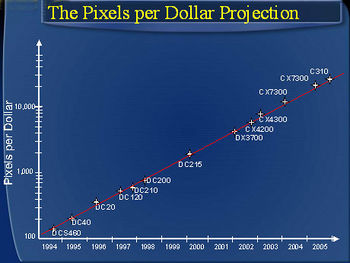
As the technology has improved, costs have decreased dramatically. Counting the "pixels per dollar" as a basic measure of value for a digital camera, there has been a continuous and steady increase in the number of pixels each dollar buys in a new camera, in accord with the principles of Moore's Law. This predictability of camera prices was first presented in 1998 at the Australian PMA DIMA conference by Barry Hendy and since referred to as "Hendy's Law".[2]
Since only a few aspect ratios are commonly used (mainly 4:3 and 3:2), the number of sensor sizes that are useful is limited. Furthermore, sensor manufacturers do not produce every possible sensor size, but take incremental steps in sizes. For example, in 2007 the three largest sensors (in terms of pixel count) used by Canon were the 21.1, 16.6, and 12.8 megapixel CMOS sensors.
Methods of image capture

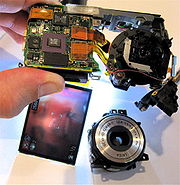
Since the first digital backs were introduced, there have been three main methods of capturing the image, each based on the hardware configuration of the sensor and color filters.
The first method is often called single-shot, in reference to the number of times the camera's sensor is exposed to the light passing through the camera lens. Single-shot capture systems use either one CCD with a Bayer filter mosaic, or three separate image sensors (one each for the primary additive colors red, green, and blue) which are exposed to the same image via a beam splitter.
The second method is referred to as multi-shot because the sensor is exposed to the image in a sequence of three or more openings of the lens aperture. There are several methods of application of the multi-shot technique. The most common originally was to use a single image sensor with three filters (once again red, green and blue) passed in front of the sensor in sequence to obtain the additive color information. Another multiple shot method is called Microscanning. This technique utilizes a single CCD with a Bayer filter but actually moved the physical location of the sensor chip on the focus plane of the lens to "stitch" together a higher resolution image than the CCD would allow otherwise. A third version combined the two methods without a Bayer filter on the chip.
The third method is called scanning because the sensor moves across the focal plane much like the sensor of a desktop scanner. Their linear or tri-linear sensors utilize only a single line of photosensors, or three lines for the three colors. In some cases, scanning is accomplished by moving the sensor e.g. when using Color co-site sampling or rotate the whole camera; a digital rotating line camera offers images of very high total resolution.
The choice of method for a given capture is determined largely by the subject matter. It is usually inappropriate to attempt to capture a subject that moves with anything but a single-shot system. However, the higher color fidelity and larger file sizes and resolutions available with multi-shot and scanning backs make them attractive for commercial photographers working with stationary subjects and large-format photographs.
Dramatic improvements in single-shot cameras and raw image file processing at the beginning of the 21st century made single shot, CCD-based cameras almost completely dominant, even in high-end commercial photography. CMOS-based single shot cameras remained somewhat common.
Filter mosaics, interpolation, and aliasing
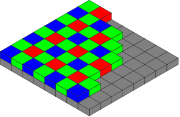
Most current consumer digital cameras use a Bayer filter mosaic in combination with an optical anti-aliasing filter to reduce the aliasing due to the reduced sampling of the different primary-color images. A demosaicing algorithm is used to interpolate color information to create a full array of RGB image data.
Cameras that use a beam-splitter single-shot 3CCD approach, three-filter multi-shot approach, Color co-site sampling or Foveon X3 sensor do not use anti-aliasing filters, nor demosaicing.
Firmware in the camera, or a software in a raw converter program such as Adobe Camera Raw, interprets the raw data from the sensor to obtain a full color image, because the RGB color model requires three intensity values for each pixel: one each for the red, green, and blue (other color models, when used, also require three or more values per pixel). A single sensor element cannot simultaneously record these three intensities, and so a color filter array (CFA) must be used to selectively filter a particular color for each pixel.
The Bayer filter pattern is a repeating 2×2 mosaic pattern of light filters, with green ones at opposite corners and red and blue in the other two positions. The high proportion of green takes advantage of properties of the human visual system, which determines brightness mostly from green and is far more sensitive to brightness than to hue or saturation. Sometimes a 4-color filter pattern is used, often involving two different hues of green. This provides potentially more accurate color, but requires a slightly more complicated interpolation process.
The color intensity values not captured for each pixel can be interpolated (or guessed) from the values of adjacent pixels which represent the color being calculated.
Connectivity
Transferring photos
Many digital cameras can connect directly to a computer to transfer data:
- Early cameras used the PC serial port. USB is now the most widely used method (most cameras are viewable as USB mass storage), though some have a FireWire port. Some cameras use USB PTP mode for connection instead of USB MSC; some offer both modes.
- Other cameras use wireless connections, via Bluetooth or IEEE 802.11 WiFi, such as the Kodak EasyShare One.
- Cameraphones and some high-end stand-alone digital cameras also use cellular networks to connect for sharing images. The most common standard on cellular networks is the MMS MultiMedia Service, commonly called "picture messaging" which is used by 1.3 billion people. The second method on cellular networks is to send a picture as an email attachment. Many cameraphones do not support email, so this is less common.
A common alternative is the use of a card reader which may be capable of reading several types of storage media, as well as high speed transfer of data to the computer. Use of a card reader also avoids draining the camera battery during the download process, as the device takes power from the USB port. An external card reader allows convenient direct access to the images on a collection of storage media. But if only one storage card is in use, moving it back and forth between the camera and the reader can be inconvenient. Many computers have a card reader built in, at least for SD cards.
Printing photos
Many modern cameras support the PictBridge standard, which allows them to send data directly to a PictBridge-capable computer printer without the need for a computer.
Wireless connectivity can also provide for printing photos without a cable connection.
Polaroid has introduced a printer integrated into its digital camera which creates a small, printed copy of a photo. This is reminiscent of the original instant camera, popularized by Polaroid in 1975.[3]
Displaying photos
Many digital cameras include a video output port. Usually sVideo, it sends a standard-definition video signal to a television, allowing the user to show one picture at a time. Buttons or menus on the camera allow the user to select the photo, advance from one to another, or automatically send a "slide show" to the TV.
HDMI has been adopted by many high-end digital camera makers, to show photos in their high-resolution quality on an HDTV.
In January 2008, Silicon Image announced a new technology for sending video from mobile devices to a television in digital form. MHL sends pictures as a video stream, up to 1080p resolution, and is compatible with HDMI.[4]
Some DVD recorders and television sets can read memory cards used in cameras; alternatively several types of flash card readers have TV output capability.
Modes
Many digital cameras have preset modes for different applications. Within the constraints of correct exposure various parameters can be changed, including exposure, aperture, focusing, light metering, white balance, and equivalent sensitivity. For example a portrait might use a wider aperture to render the background out of focus, and would seek out and focus on a human face rather than other image content.
Image data storage

Many camera phones and most separate digital cameras use memory cards having flash memory to store image data. The majority of cards for separate cameras are SD format; many are CompactFlash or other formats.
Digital cameras have computers inside, hence have internal memory, and many cameras can use some of this internal memory for a limited capacity for pictures that can be transferred to or from the card or through the camera's connections.
A few cameras use some other form of removable storage such as Microdrives (very small hard disk drives), CD single (185 MB), and 3.5" floppy disks. Other unusual formats include:
- Onboard flash memory — Cheap cameras and cameras secondary to the device's main use (such as a camera phone)
- PC Card hard drives — early professional cameras (discontinued)
- Thermal printer — known only in one model of camera that printed images immediately rather than storing
 Microdrive (CF-II) |
 Mini CD (left) |
Most manufacturers of digital cameras do not provide drivers and software to allow their cameras to work with Linux or other free software. Still, many cameras use the standard USB storage protocol, and are thus easily usable. Other cameras are supported by the gPhoto project.
File formats
The Joint Photography Experts Group standard (JPEG) is the most common file format for storing image data. Other file types include Tagged Image File Format (TIFF) and various Raw image formats.
Many cameras, especially professional or DSLR cameras, support a Raw image format. A raw image is the unprocessed set of pixel data directly from the camera's sensor. They are often saved in formats proprietary to each manufacturer, such as NEF for Nikon, CRW or CR2 for Canon, and MRW for Minolta. Adobe Systems has released the DNG format, a royalty free raw image format which has been adopted by at least 10 camera manufacturers.
Raw files initially had to be processed in specialized image editing programs, but over time many mainstream editing programs, such as Google's Picasa, have added support for raw images. Editing raw format images allows more flexibility in settings such as white balance, exposure compensation, color temperature, and so on. In essence raw format allows the photographer to make major adjustments without losing image quality that would otherwise require retaking the picture.
Formats for movies are AVI, DV, MPEG, MOV (often containing motion JPEG), WMV, and ASF (basically the same as WMV). Recent formats include MP4, which is based on the QuickTime format and uses newer compression algorithms to allow longer recording times in the same space.
Other formats that are used in cameras but not for pictures are the Design Rule for Camera Format (DCF), an ISO specification for the camera's internal file structure and naming, and Digital Print Order Format (DPOF), which dictates what order images are to be printed in and how many copies.
Most cameras include Exif data that provides metadata about the picture. Exif data may include aperture, exposure time, focal length, date and time taken, and location.
Batteries
Digital cameras have high power requirements, and over time have become smaller, resulting in an ongoing need to develop a battery small enough to fit in the camera and yet able to power it for a reasonable length of time.
Two broad types of batteries are in use for digital cameras.
Off-the-shelf
The first type of battery for digital cameras conform to an established off-the-shelf form factor, most commonly AA, CR2, or CR-V3 batteries, with AAA batteries in a handful of cameras. The CR2 and CR-V3 batteries are lithium based, and intended for single use. They are also commonly seen in camcorders. AA batteries are the most common; however, the non-rechargeable alkaline batteries supplied with low-end cameras are capable of providing enough power for only a very short time in most cameras. They may serve satisfactorily in cameras that are only occasionally used.
Consumers with more than an occasional need use AA Nickel metal hydride batteries (NiMH) instead, which provide an adequate amount of power and are rechargeable. NIMH batteries do not provide as much power per volume as lithium ion batteries, and they also tend to discharge when not used. They are available in various ampere-hour (Ah) or milli-ampere-hour (mAh) ratings, which affects how long they last in use. Typically mid-range consumer models and some low end cameras use off-the-shelf batteries; only a very few DSLR cameras accept them (for example, Sigma SD10). Rechargeable RCR-V3 lithium-ion batteries are also available as an alternative to non-rechargeable CR-V3 batteries.
Proprietary
The second type of battery for digital cameras is proprietary battery formats. These are built to a manufacturer's custom specifications, and can be either aftermarket replacement parts or OEM. Almost all proprietary batteries are lithium ion. While they only accept a certain number of recharges before the battery life begins degrading (typically up to 500 cycles), they provide considerable performance for their size. A result is that at the two ends of the spectrum both high end professional cameras and low end consumer models tend to use lithium ion batteries.
See also
References
- ↑ Musgrove, Mike (2006-01-12). "Nikon Says It's Leaving Film-Camera Business". Washington Post. http://www.washingtonpost.com/wp-dyn/content/article/2006/01/11/AR2006011102323.html. Retrieved 2007-02-23.
- ↑ Bogdan Solca (2007-01-08). "More on digital cameras". Softpedia. http://news.softpedia.com/news/Digital-Lens-Flares-43923.shtml.
- ↑ "Reinventing Instant Photography for the Digital Age". Polaroid. January 8, 2009. http://thenewinstant.com/news-updates/Polaroid%20Introduces%20the%20Polaroid%20PoGo%E2%84%A2%20Instant%20Digital%20Camera/. Retrieved 2009-01-15.
- ↑ "Mobile High-Definition Link Technology Gives Consumers the Ability to Link Mobile Devices to HDTVs with Support for Audio and Video". Silicon Image. January 7, 2008. http://www.siliconimage.com/news/releasedetails.aspx?id=480. Retrieved 2009-01-15.
External links
- Howstuffworks Digital Cameras
- Year-by-year developments up to 1998 and images of several types of cameras
- Architecture of a still-motion-/picture digital camera
- Digital Camera in the Classroom
- The invention of the digital camera at Kodak (1975!)
|
||||||||||||||||||||||||||||||||
